- A garden shelter should preferably be at least
half the height of the nearest house away to
avoid debris from collapsed buildings. It should
also be away from large trees. Before removing
earth check that you cannot damage drainage or
other services.
Planning permission, Building
Regulations and rating
If you wish to install a permanent shelter you may
need permission. You should check the regulations before
submitting plans or beginning work. Your local
District Council will tell you about planning permission
and the Building Regulations. A permanent shelter may
affect the rateable value of your home, and this is a
matter for your local District Valuer and Valuation
Officer (Regional Assessor in Scotland).
Type
1a
Easily-constructed improvised
garden shelter using household materials
This shelter is suitable for areas where under ground
shelters are impracticable, for example, where there is a
high water table, so that a deep hole fills with water.
It can be constructed using only materials which are
generally available, and could be built in a time of
crisis. It would take two people about 24 working
hours each to build.
The shelter consists of a shallow trench dug into the
ground with a roof of doors or sheet timber that is
supported above ground level by earth walls. The
structure is then covered by at least 18 in. of earth.
This basic design will give good protection from fallout
radiation particularly if the occupants keep away from
the entrance area. If, in addition, a barrier of sandbags
or packed soil is built about two feet in front of the
entrance, and to the same height, the protection in the
entrance area will be improved.
Construction
1. Select a site on
level ground where there is little chance of rainwater
collecting.
2. You will need:
- i. Pick, shovel or spade (preferably both),
wheelbarrow or buckets, saw, screw-driver, knife,
tape measure, pencil and paper, and a pair of
gloves.
ii. Pieces of large sheeting material.
e.g. carpets. blankets. sheets, heavy duty
polythene, sacking etc. for making earth rolls (Fig
7).
iii. Plastic bags or pillowcases for making
sandbags.
iv. Timber: pieces of 2 in. x 4 in. wood at
least 3 ft long are must useful although any
suitable strong timber could be used for the
cross braces (Fig 6). Floor-boards about 4 ft
long could be used for entrance and exit tunnels
(Fig 13).
v. Nails: 100 x 2 in. steel nails, 30 x 4 in.
steel nails.
vi. Doors: one door (normally about 30 in.
wide) per person is required, together with one
door each for entrance and exit. Fittings such as
handles should be removed. If you do not have
enough doors, sheet timber can be used.
vii. Rainproofing material to cover the doors,
e.g. polythene sheeting, shower curtains and
vinyl floorcovering .
viii. Pegs and string for markers and tying
sandbags.
3. Construct the
shelter as shown in Figs 4-14.
4. Furnish the
shelter as required.



40 in. by 2 in. temporary timber braces between doors.
Doors in position - construct temporary supporting
structure of doors and timber against which earth rolls
can be built (frame is removed later and doors, then used
to form a roof).

Fig 8 - Construction of
earth rolls




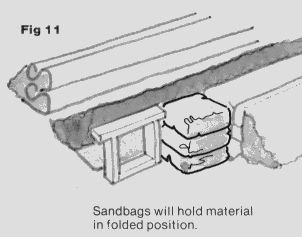
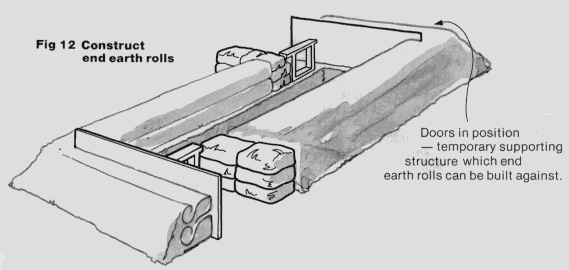
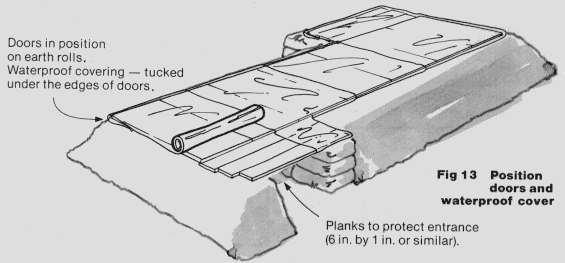
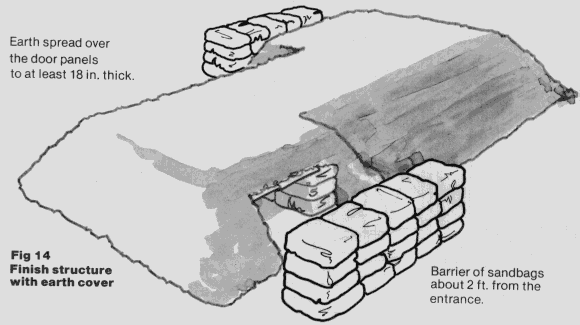
Type
1b
Improvised outdoor shelter using
do-it-yourself materials
The following diagrams show how a basic shelter can be
constructed from standard scaffold poles and other
materials available from builders merchants, timber yards
and do-it-yourself stores.
This type of shelter could be constructed in a time of
crisis from materials previously purchased and stored. It
would take two people about 24 working hours each to
build this shelter - the size is adaptable.
The dimensions given would accommodate a family of four
for a short period or two people plus provisions for
longer.
This shelter uses steel or alloy, standard diameter
scaffold poles. These are arranged in a series of 'A'
frames over a trench. It is necessary to brace the frames
with further scaffolding both diagonally along its length
and across the waists of the 'A' sections to give
rigidity. In both cases proprietary clamps are the best
method of securing the scaffold poles to each other.
Prepare a trench 8 ft. x 8 ft. and at least 1 ft. 6 in.
deep. Line it with heavy duty polythene sheeting. Lay a
floor of two sheets of plywood, 3/4 in. thick and 4 ft. x
8 ft.
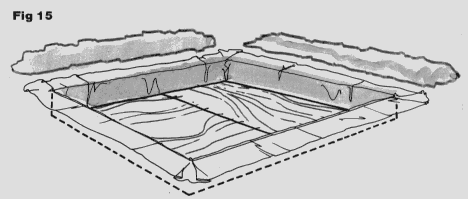
Construct the frame of scaffold poles (or you could
use wood). This should be as strong as you can make it.
You can increase the strength with vertical and diagonal
bracing, or crossbars.
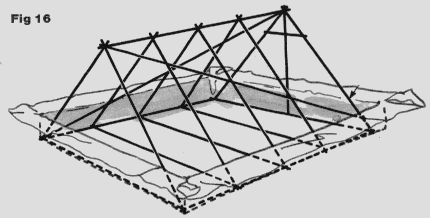
Add the frame for the entrance tunnel, and also the
ventilation pipe (described opposite).
Cover the entire frame (except the entrance hole) with
plywood boarding. Any small gaps or sharp edges should be
covered with carpet or thick fabric.
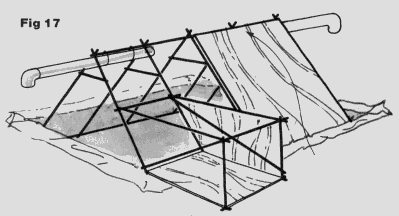
Wrap the shelter with overlapping sheets of heavy duty
polythene. Make sure the trench lining is within this
cover.
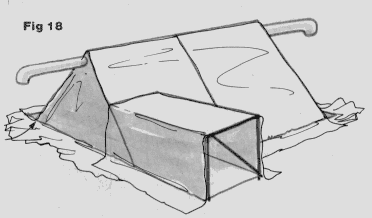
Finally, cover the shelter with a thick layer of earth
(about 18 in.). The earth removed from the trench may not
be enough for this. It you decide to dig a deeper initial
trench to get enough earth to cover, you may need to make
some modifications to the design given here.
The shelter will give better blast protection if you
put a layer of resilient material between the polythene
and the earth covering. Straw, mattresses, or similar,
would be suitable.
The entrance can be filled from within with small bags of
sand or earth. You will have to store these inside the
shelter.

Ventilation
For this shelter you will need to make some provision
for ventilation. The diagrams show metal drainpipes with
a bend near the opening, so that this faces downward. The
opening should then be filled with a filter of steel wool.
It is extremely important to ensure that ventilation
pipes are secure and kept free of obstruction.
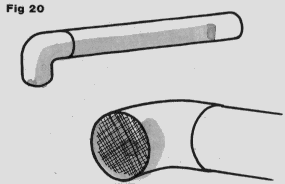
| The following two designs are intended to be
sold by manufacturers as kits together with
installation instructions. Design drawings are to
be found in Domestic Nuclear Shelters -
Technical Guidance. |
Type
2
Indoor shelter from manufactured
kit
This type of shelter - basically a protective steel
table - is suitable for homes that have basements or
rooms that can be converted into 'fallout rooms' (described
in Protect and Survive) provided that the floor is strong
enough to support it.
This shelter will sustain the debris load resulting from
the complete collapse of a normal two-storey house. To
obtain protection from fallout, it must be surrounded
with dry-laid bricks, sand or earth bags or heavy
furniture filled with sand, earth or books.
The shelter is designed to accommodate two adults and two
children. Two shelters or more may be put together to
increase the capacity.
It would take two people about two hours to erect the
shelter itself and up to an additional 20 hours to
surround it with protective material.
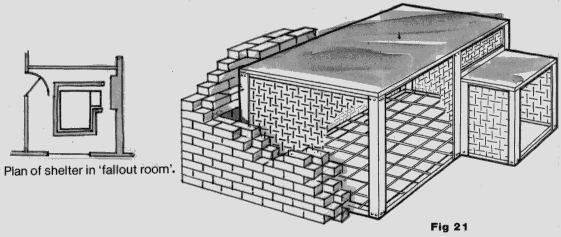
Type
3
Outdoor shelter from a
manufactured kit
This type of shelter is generally suitable where there
is a garden or other convenient land near the living
accommodation. It is formed by building a strong
structural shell with prefabricated steel components
bolted together to form a sealed room of sufficient size
for up to six people. The shell is semi-sunk in the
ground and covered entirely by earth from the excavation.
There will be variations both in materials and
construction depending upon the costs. The assembly of
the shell would take a full days work for two people. The
excavation could, however, take at least a week for two
people digging by hand.
While the kit could be bought in readiness and digging
and installation done over a period of time the materials
would have to be non-corrosive, and not likely to
deteriorate.
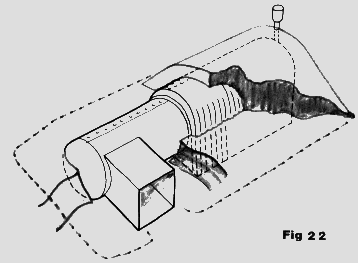
Type
4
Permanent purpose-built shelter
This reinforced concrete shelter must be erected by a
building contractor under the guidance of a chartered
civil/structural engineer. It should on no account be
erected by unskilled or unsupervised labour.
If properly constructed it will give a high degree of
protection against both blast and radiation. It can be
designed to accommodate from six to 12 people and the
cost will vary accordingly.
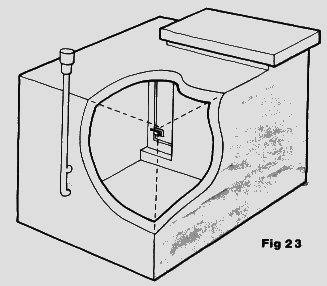
Stocking
your shelter
Life in the confined space of a survival shelter needs
careful planning.
You should store as much as possible of the
following in your shelter:
Water
Water in sealed or covered containers to last you and
your family for 14 days. Four pints per person per day
would be sufficient for drinking and basic cleanliness.
Food
Enough food for 14 days, including tinned or powdered
milk for the children and food for the baby - and a
closed cupboard or cabinet in which to store these
supplies.
A nutritionally balanced diet is not important for this
length of time. A list of suggested foods and quantities
for one adult is given at the back of this booklet. These
have been chosen because they store easily and most can
be eaten cold.
Nursing mothers will need extra food and children between
the ages of one and five years should be counted as half
an adult for the purposes of food stocks. They should
also have the equivalent in dried or evaporated milk of
one pint of milk per day. If your family includes a baby
that is not breast fed you should provide dried infant
formula.
Alternatives to this are 7kg of full cream evaporated
milk and 1/2kg sugar or 2 1/2kg full cream dried milk and
1/2kg sugar, which should be sufficient for two weeks. To
this can be added mashed 'adult' foods if the infant is
more than three or four months old.
Radio
A portable radio (and a spare if possible) and spare
batteries.
This is absolutely essential. It will be your only way of
receiving instructions on when it is sate to leave your
shelter and for how long. In the case of shelter types 3
and 4 an external aerial may be necessary.
Miscellaneous
Tin opener, bottle opener, cutlery, crockery and
cooking utensils.
Warm clothing and footwear and changes of clothing.
Bedding. sleeping bags, etc.
Torches with spare bulbs and batteries, candles and
matches. Open flames should not be used in shelter types
3 and 4 until the shelter door can be opened.
Toilet articles and washbowls.
First aid kit.
Notebooks and pencils for noting radio instructions.
Cleaning materials: including cloths, tissues, brushes,
shovels and box of dry sand.
Garden spade
Improvised lavatory seat, polythene buckets fitted
with covers, polythene bag linings for emptying the
contents, strong disinfectant and toilet paper.
Alternatively camping or caravan type toilet arrangements
may be used.
Clock and calendar.
and just outside your shelter
Dustbin for temporary storage of waste matter.
Second dustbin for food remains. empty tins and other
rubbish.
Polythene bag or bin for outdoor clothes and boots.
If possible. extra water supplies in covered
containers, and games, children's toys and books.
Stoves burning liquid fuel or gas may be used at or
just outside the entrance of shelter types 1, 1a and 2,
or in a similar way in types lb, 3 and 4 but only when it
is safe to open the hatch or door. Otherwise you should
not use a stove of this kind in a sealed shelter.
Suggested food list
Supplies for two weeks for one
adult
|

























